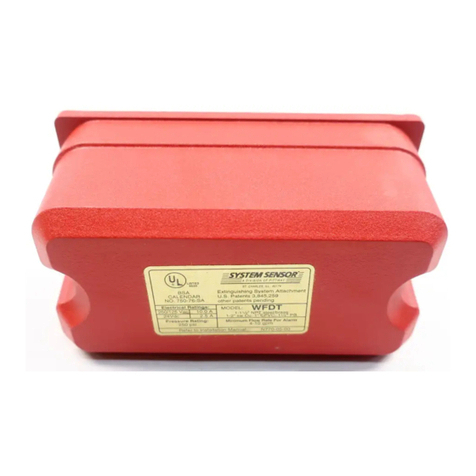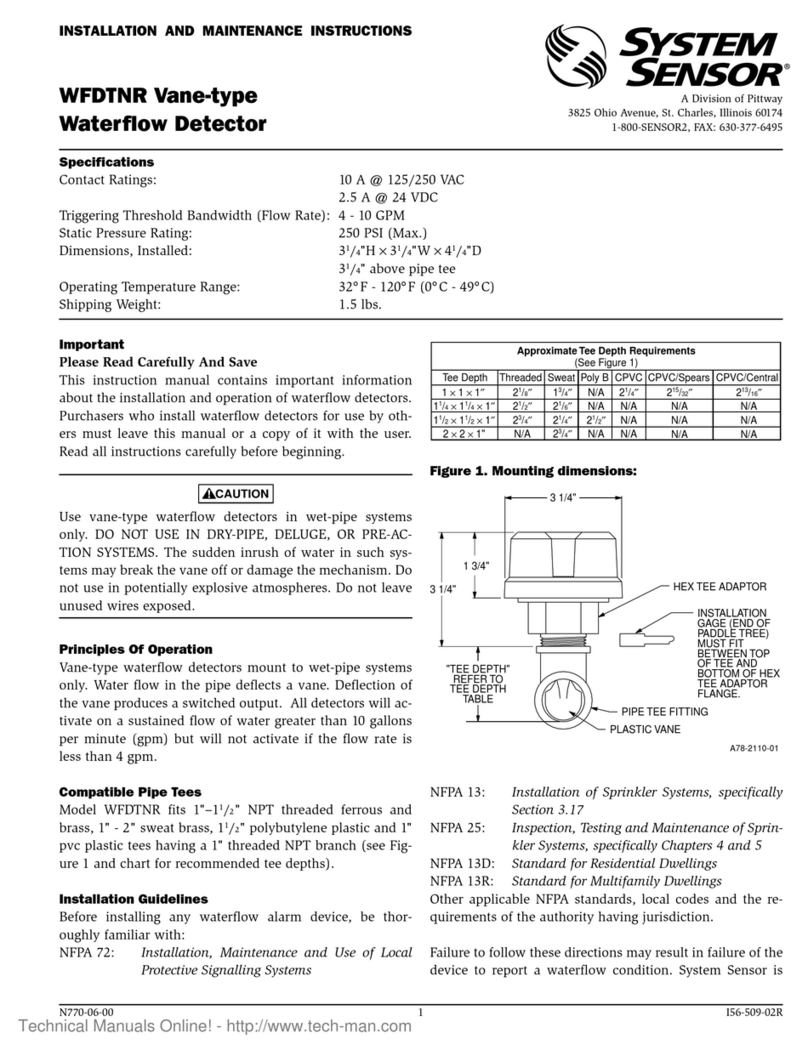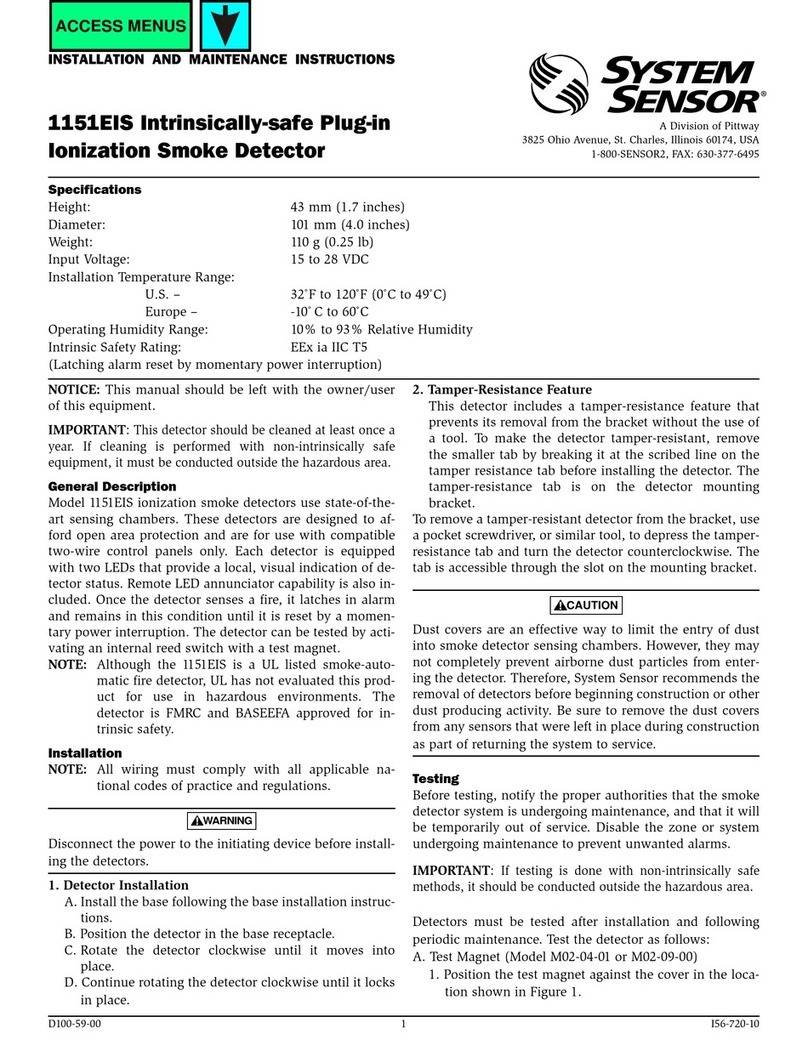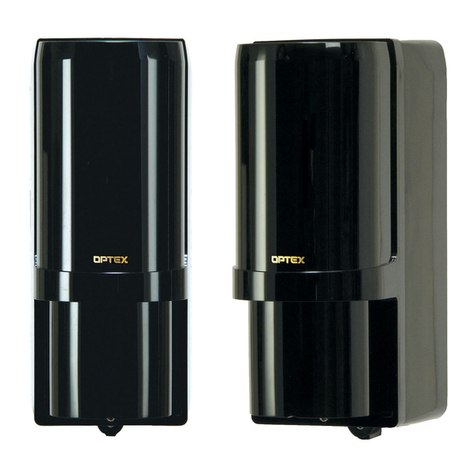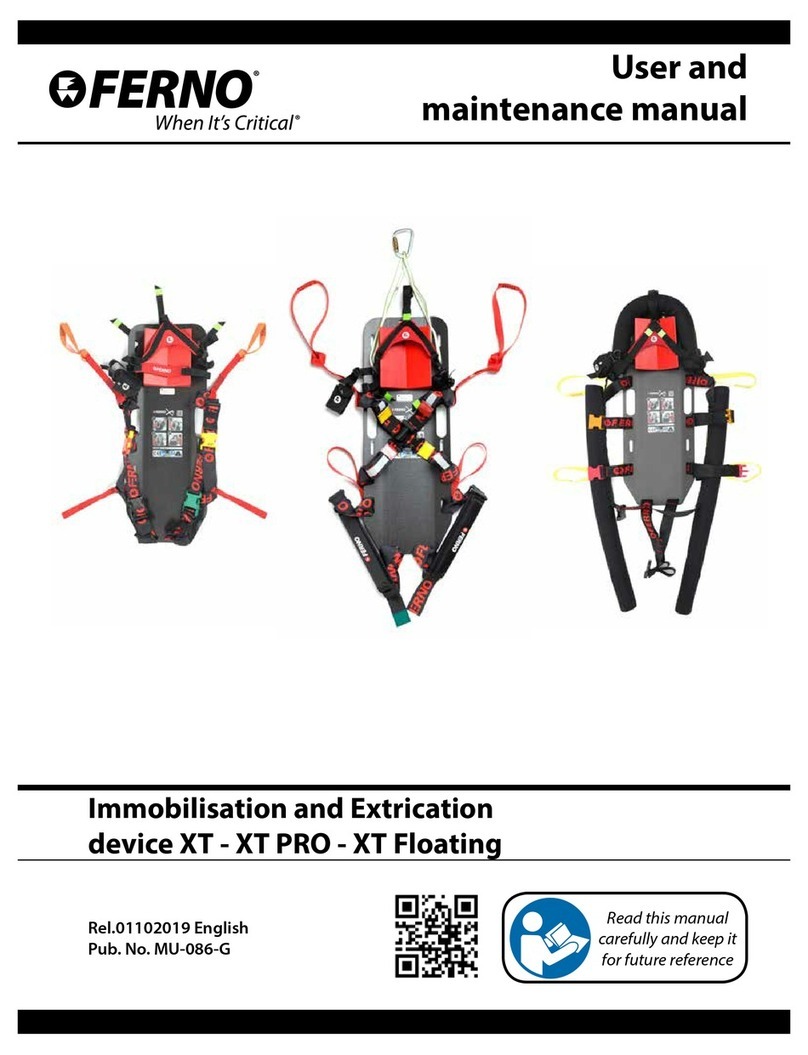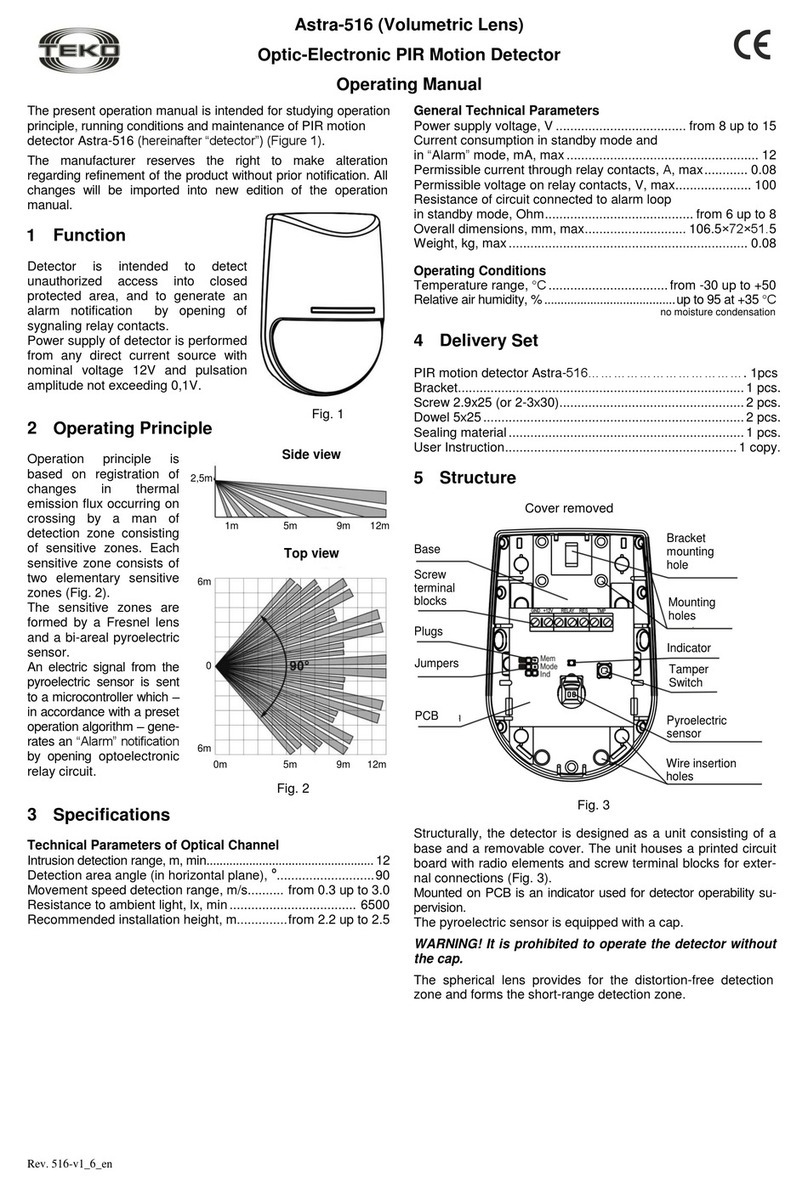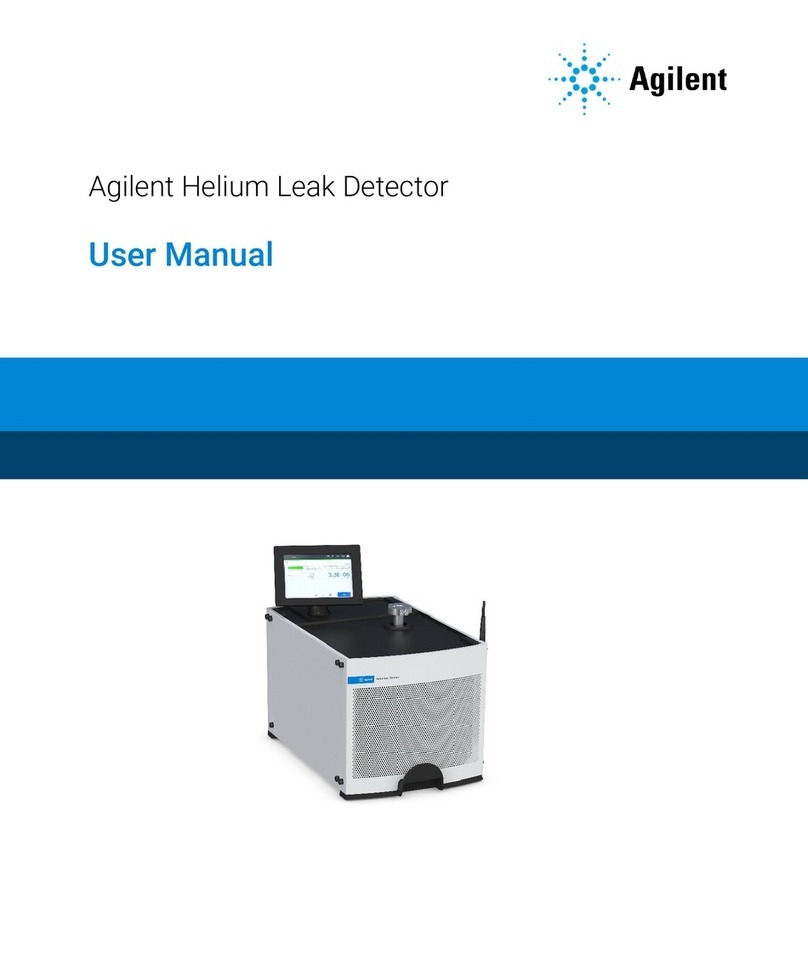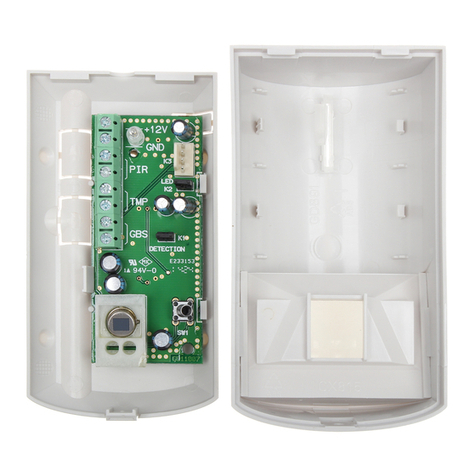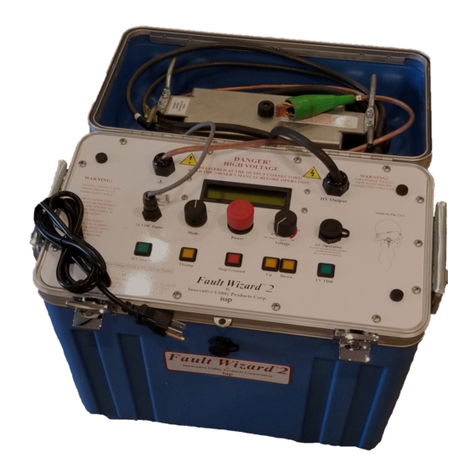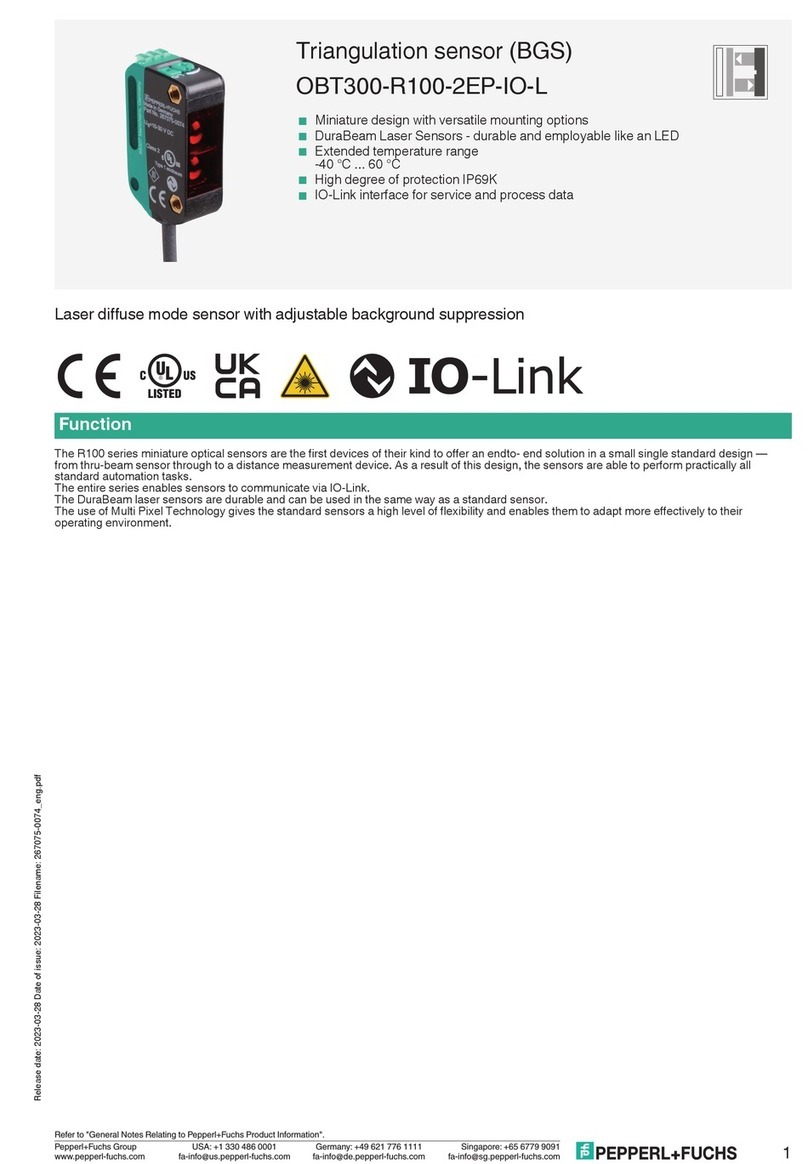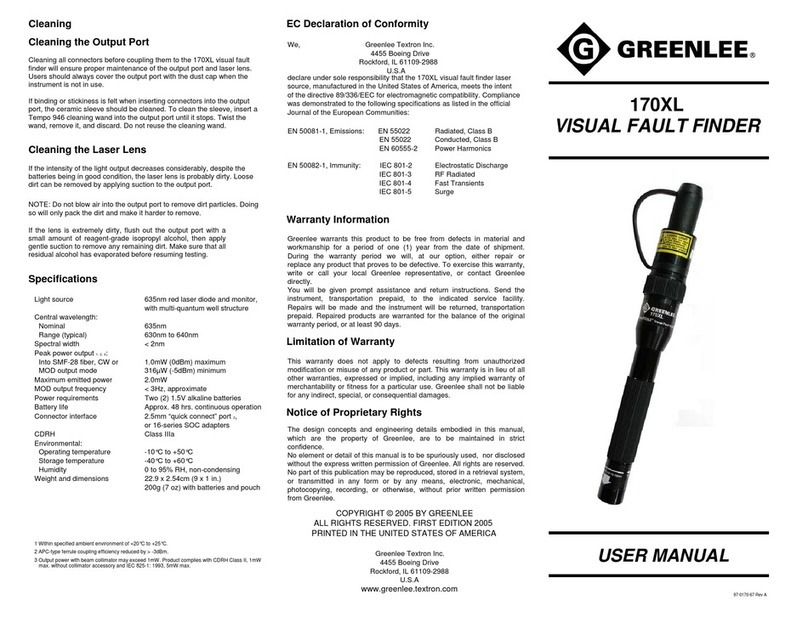Pittway SYSTEM SENSOR 5451EIS User manual

D400-56-00 1 I56-699-11
5451EIS Plug-in Intrinsically Safe
Rate-of-rise Thermal Detector with
Fixed Temperature Alarm
INSTALLATION AND MAINTENANCE INSTRUCTIONS
A Division of Pittway
3825 Ohio Avenue, St. Charles, Illinois 60174, USA
1-800-SENSOR2, FAX: 630-377-6495
This sensor must be installed in compliance with the con-
trol panel installation manual and meet the requirements of
the authority having jurisdiction.
NOTICE: This manual should be left with the owner/user
of this equipment.
IMPORTANT: This detector should be cleaned at least once
a year. If cleaning is performed with non-intrinsically safe
equipment, it must be conducted outside the hazardous
area.
General Description
Model 5451EIS is an intrinsically safe rate-of-rise thermal
detector with fixed temperature alarm utilizing a state-of-
the-art dual thermistor sensing circuit. These detectors are
designed to provide open area protection and are to be
used with compatible control panels only. Two LEDs on
each detector light to provide 360°visibility of the detector
indication. Remote LED annunciator capability is provided
as standard.
NOTE: Although the 5451EIS is a UL listed open area heat
detector, UL has not evaluated this product for use
in hazardous environments. The detector is FMRC
and BASEEFA approved for intrinsic safety.
Installation
NOTE: All wiring must conform to applicable installation
codes and regulations.
NOTE: Verify that all detector bases are installed, that the
initiating-device circuits have been tested, and that
the wiring is correct. (Refer to detector base
manual for testing procedure.)
WARNING
Disconnect the power from initiating-device circuits before
installing detectors.
Specifications
Diameter: 10.4 cm
Height: 5.4 cm
Weight: 150 g
Input Voltage: 15 to 28 VDC
Installation Temperatures:
U.S. – 32°F to 100ºF (0ºC to 40ºC)
Europe (Maximum)– 50°C
Operating Humidity Range: 10% to 93% Relative Humidity (noncondensing)
Latching Alarm: Reset by momentary power interruption
Intrinsic Safety Rating: EEx ia IIC T5
1. Install Detectors:
a. Insert the detector into the detector base.
b. Turn the detector clockwise until the detector drops
into place.
c. Continue turning detector clockwise to lock it in
place.
Tamper-resistance Feature
The detector bases include a feature that, when ac-
tivated, prevents removal of the detector from the
base without the use of a tool. Refer to the instal-
lation instruction manual of the detector base to
make use of this feature.
2. After all detectors have been installed, apply power to
the control unit.
3. Test the detector using the magnet as described under
TESTING.
4. Reset the detector at the system control panel.
5. Notify the proper authorities the system is in operation.
Testing
Before testing, notify the proper authorities that the heat
detector system is undergoing maintenance, and therefore
the system will temporarily be out of service. Disable the
zone or system undergoing maintenance to prevent un-
wanted alarms.
IMPORTANT: If testing is done with non-intrinsically safe
methods, it should be conducted outside the hazardous
area.
Detectors must be tested after installation and periodic
maintenance. The 5451EIS may be tested as follows:
A. Test Magnet (System Sensor Model No. M02-04)
ACCESS MENUS

D400-56-00 2 I56-699-11
1. Position the magnet against the cover opposite the
test module socket. (See Figure 1.)
2. The LEDs on the detector should light within 10 sec-
onds. If the LEDs fail to light, check the power to the
detector and the wiring in the detector base.
3. Reset the detector at the system control panel.
B. Test Module (System Sensor Model No. MOD400R)
The MOD400R is used with a DMM or volt meter to
check the detector sensitivity as described in the
module’s manual.
C. Direct Heat Method (Hair dryer of 1000 - 1500 watts)
From the side of the detector, direct the heat toward the
sensor. Hold the heat source about 15 cm away to pre-
vent damage to the cover during testing.
NOTE: If a detector goes into alarm, it will reset only if the
detector has cooled and if its power is momentarily
interrupted. Check the control panel being used to
determine whether the RESET switch (or some
other auxiliary device or control) momentarily cuts
off power to the detector loop.
Detectors that fail these tests should be cleaned as de-
scribed under MAINTENANCE and retested. If the detec-
tors still fail these tests they should be returned for repair.
Figure 1:
Maintenance
The 5451EIS detector has been designed to be as mainte-
nance-free as possible. Normal air-borne dust, however,
can accumulate on the detector’s sensing elements and
cause them to become less sensitive. All detectors should
be tested and cleaned at least once a year, and those in
dustier areas should be tested and cleaned more often. De-
tectors must also be cleaned and tested immediately after a
fire. Before cleaning, notify the proper authorities that the
system is undergoing maintenance, and therefore the sys-
tem will temporarily be out of service. Disable the loop or
system undergoing maintenance to prevent unwanted
alarms.
1. Remove detector from mounting base.
2. Use a vacuum cleaner to remove dust from the sensing
chamber.
3. Reinstall the detector.
4. Test detector as described under TESTING.
WARNING
The Limitations of Property Protection Heat Detectors
Heat detectors do not always detect fires because the fire may be a
slow-smoldering, low-heat type (producing smoke), or because they
may not be near where the fire occurs, or because the heat of the fire
may bypass them. Heat detectors will not detect smoke, gas, flames, or
combustion particles.
Heat detectors are components in professionally installed fire alarm
systems. They will not function if they have been improperly wired
into the fire alarm system or if power to them is cut off for any reason.
Heat detectors cannot last forever. They should be tested and maintained
following the instructions in this manual. To be safe, they should be
replaced after they have been installed for 15 years.
Refer to NFPA 72 for application.
This heat detector is designed to activate and initiate emergency action,
but will do so only when it is used in conjunction with an authorized fire
alarm system. This detector must be installed in accordance with NFPA
standard 72.
Heat detectors will not work without power. AC or DC powered smoke
detectors will not work if the power supply is cut off for any reason.
Heat detectors are designed to protect property, not life. They do not
provide early warning of fire and cannot detect smoke, gas, combustion
particles, or flame. They alarm when temperatures at the heat detector
reach 57°C (135°F). Given the rapid growth of certain types of fires, heat
detectors cannot be expected to provide adequate warning of fires
resulting from smoking in bed, inadequate fire protection practices,
violent explosions, escaping gas, improper storage of flammable liquids
like cleaning solvents, other safety hazards, or arson.
ACCESS MENUS

D400-56-00 3 I56-699-11
Safe area apparatus, which is
unspecified except that it must
not be supplied from or contain
under normal or abnormal
conditions a source of potential
with respect to earth in excess of
250 Vrms or 250 VDC
Shunt Zener
Diode Safety
Barrier or
Isolation Barrier
(Note 1)
SAFE AREA HAZARDOUS AREA
(Note 2)
}To next
detector(s)
Table 1
Group Capacitance Inductance L/R Ratio
µFmHµH/OHM
IIC 0.13 4.2 55
IIB 0.39 12.6 165
IIA 1.04 33.6 440
Notes:
1. Any single channel shunt zener diode safety barrier or single channel of a dual channel shunt zener diode safety barrier certified
by BASEEFA or any EEC approved certification body to [EEx ia] IIC having the following
or lower output parameters:
Uz = 28V
Imax: out = 93.3 mA
Wmax: out = 0.67 W
In any safety barrier used, the output current must be limited by a resistor "R", such that Imax:out = Uz/R.
Or any of the following isolation barriers may be used:
MTL : MTL3043 (Ex86B2285), MTL4061 (Ex94C2040), MTL5061 (Ex96D2426)
Pepperl + Fuchs : KHDO-ICS/Ex151 (Ex88B2331), KHDO-ICS/Ex251 (Ex88B2331), KFDO-CS-Ex151 (Ex88B2331)
2. The capacitance and inductance or inductance/resistance (L/R) ratio of the hazardous area cables must not
exceed the values shown in Table 1.
3. The installation must comply with the appropriate national installation requirements, e.g. in the U.K. BS5345:
Part 4:1977.
4. The electrical circuit in the hazardous area must be capable of withstanding an A.C. test voltage of 500 VRMS to earth or frame of
the apparatus for one minute. This note does not apply when using an isolation barrier.
5. An external light emitting diode (LED) may be fitted to terminals 2 and 1 (B401 base). The surface area of the LED must lie be-
tween 20mm2and 10cm2. The LED and its terminations must be afforded a degree of protection of at least IP20, and be segregated
from other circuits and conductors as defined in clause 5 of EN50020: 1977.
6. The zone wiring of the detector bases should be checked before the detector heads are installed. To make this possible, this
base contains a special spring-type shorting jumper. After a detector base is properly wired and mounted to an electrical box,
make sure that the shorting spring is in contact with terminal 3. This temporary connection permits the wiring of the loop to be
checked for continuity before installation of the detector heads. The shorting spring in the base automatically disengages when
the detector head is removed from the base. DO NOT remove the shorting spring since it reengages as the detector head is
turned in the base, completing the circuit.
R12-167-00, REV A
OR
(Note 5)
3 2 1 4
INTEGRATION OF THE 5451EIS DETECTORS INTO A SYSTEM
(B401 Base)
Model 5451EIS
heat detector
EEx ia IIC T5
BASEEFA No.:
EX94C2431
CAUTION
Please refer to control panel installation instructions for specific barrier/control panel compatibility information.
ACCESS MENUS

SAFE AREA HAZARDOUS AREA
(Note 2.)
}
To next
detector(s)
(Note 5.)
3214
FMRC Approved System Diagram
INTEGRATION OF THE 5451EIS DETECTORS INTO A SYSTEM
Safe area apparatus, which is
unspecified except that it must
not be supplied from or contain
under normal or abnormal
conditions a source of potential
with respect to earth in excess of
250 Vrms or 250 VDC
FMRC Entity
Approved
Intrinsic Safety
Barrier
Model 5451EIS
detector
Notes:
1. Any single channel shunt zener diode safety barrier or single channel of a dual channel shunt zener diode safety barrier certified
by FMRC.
2. The entity concept allows interconnection of intrinsically safe apparatus to associated apparatus not specifically examined in
such combination. The criteria for interconnection is the voltage (Vmax) and current (Imax) that an intrinsically safe apparatus
can receive and remain intrinsically safe, considering faults, must be equal to or greater than the voltage (Voc or Vz) and current
(Isc or Iz) levels which can be delivered by the associated apparatus, considering faults and applicable factors. In addition, the
maximum unprotected capacitance (Ci) and inductance (Li) of the intrinsically safe apparatus, including interconnecting wiring,
must be equal to or less than the capacitance and inductance that can be safely connected to associated apparatus.
3. The installation shall be in accordance with NEC NASI/NFPA 70 and ANSI/ISA RP126.
4. Associated apparatus must be installed in accordance with manufacturers' instructions.
5. An external light emitting diode (LED) should be mounted in an enclosure conforming to the requirements set forth in ANSI/ISA
Standard S82.01, S82.02 and S82.03.
6. No revisions without prior FMRC authorization.
7. The zone wiring of the detector bases should be checked before the detector heads are installed. To make this possible, this
base contains a special spring-type shorting jumper. After a detector base is properly wired and mounted to an electrical box,
make sure that the shorting spring is in contact with terminal 3. This temporary connection permits the wiring of the loop to be
checked for continuity before installation of the detector heads. The shorting spring in the base automatically disengages when
the detector head is removed from the base. DO NOT remove the shorting spring since it reengages as the detector head is
turned in the base, completing the circuit.
R12-164-00, REV A
09 / 06 / 96
Maximum Parameters
Vmax = 28 V
Imax = 93.3 mA
Ci = 0
Li = 0 Class I, Division 1, Groups A, B, C, D
Hazardous (classified) locations
(B401 Base)
D400-56-00 4 I56-699-11
© System Sensor 1998
Three-Year Limited Warranty
System Sensor warrants its enclosed heat detector to be free from defects
in materials and workmanship under normal use and service for a period
of three years from date of manufacture. System Sensor makes no other
express warranty for this heat detector. No agent, representative, dealer, or
employee of the Company has the authority to increase or alter the obliga-
tions or limitations of this Warranty. The Company’s obligation of this
Warranty shall be limited to the repair or replacement of any part of the
heat detector which is found to be defective in materials or workmanship
under normal use and service during the three year period commencing
with the date of manufacture. After phoning System Sensor’s toll free
number 800-SENSOR2 (736-7672) for a Return Authorization number,
send defective units postage prepaid to: System Sensor, Repair Depart-
ment, RA #__________, 3825 Ohio Avenue, St. Charles, IL 60174. Please
include a note describing the malfunction and suspected cause of failure.
The Company shall not be obligated to repair or replace units which are
found to be defective because of damage, unreasonable use, modifica-
tions, or alterations occurring after the date of manufacture. In no case
shall the Company be liable for any consequential or incidental damages
for breach of this or any other Warranty, expressed or implied whatsoever,
even if the loss or damage is caused by the Company’s negligence or fault.
Some states do not allow the exclusion or limitation of incidental or conse-
quential damages, so the above limitation or exclusion may not apply to
you. This Warranty gives you specific legal rights, and you may also have
other rights which vary from state to state.
ACCESS MENUS
Table of contents
Other Pittway Security Sensor manuals
Popular Security Sensor manuals by other brands

Sinope
Sinope WL4200C quick start guide
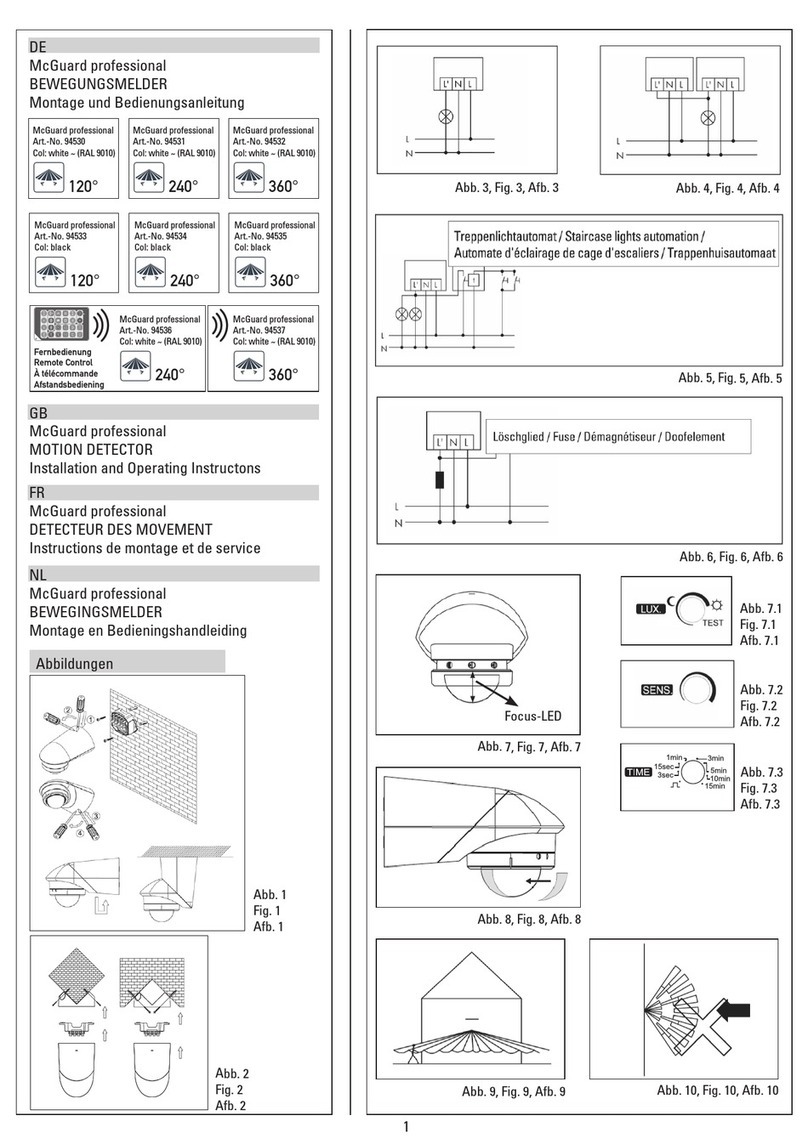
urmet domus
urmet domus Grothe McGuard professional 120 Installation and Operating Instrucitons

SPY
SPY 670 operating instructions
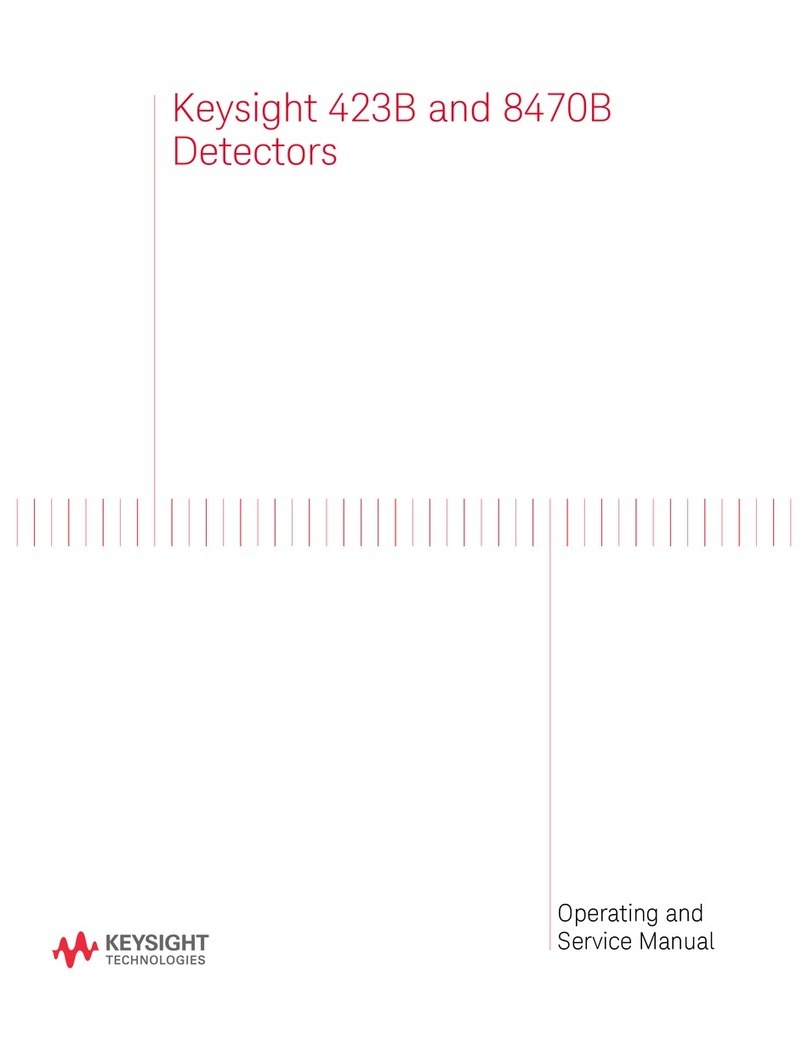
Keysight Technologies
Keysight Technologies 423B Operating and service manual
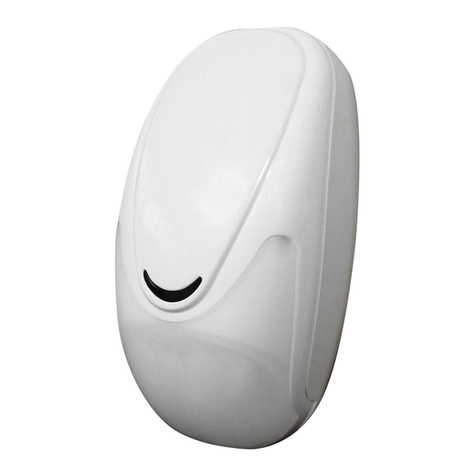
AMC
AMC MOUSE 01 manual
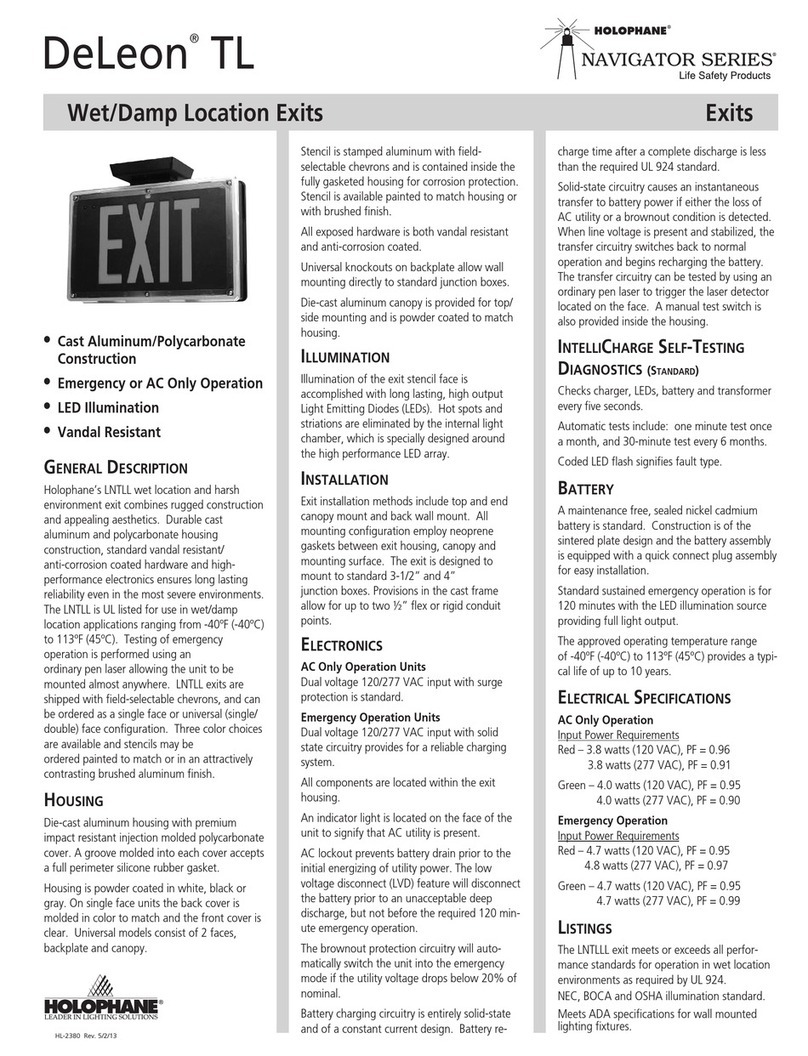
HOLOPHANE
HOLOPHANE Navigator Series General description

